No CrossRef data available.
Published online by Cambridge University Press: 28 August 2024

1 Ryan Gilbey, ‘“We Sing the Word Faggot Lovingly, Hundreds of Times”: Inside Manchester's Queerest Show’, Guardian, 26 June 2023, www.theguardian.com/music/2023/jun/26/faggots-friends-revolution-manchester-queerest (accessed 1 March 2024).
2 Flora Willson, ‘The Faggots and Their Friends Between Revolutions Review – Unforgettable Celebration of Queer Activism’, Guardian, 29 June 2023, www.theguardian.com/music/2023/jun/29/the-faggots-and-their-friends-between-revolutions-review-manchester (accessed 1 March 2024).
3 Mitchell, Larry and Asta, Ned, The Faggots and Their Friends Between Revolutions (New York: Calamus Books, 2019), p. 13Google Scholar.
4 Freeman, Elizabeth, Time Binds: Queer Temporalities, Queer Histories (Durham, NC: Duke University Press, 2010), p. xiiiGoogle Scholar.
5 Ibid., p. xvi.
6 Mitchell and Asta, The Faggots and Their Friends, p. 14.